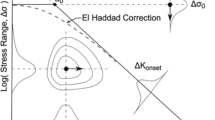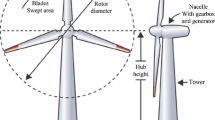Abstract
This paper presents an ultrasonic inspection methodology to improve the fitness-for-service (F.F.S) assessment of hydraulic turbine runners after manufacturing or during the in-service inspection. The improvement proposed here is to apply ultrasonic array inspection techniques with an emphasis on the total focusing method (TFM) to produce data compatible with fitness-for-service methodologies. Conventional ultrasonic inspection methods based on good workmanship are mandatory for manufacturing, and in-service inspections are generally limited to surface methods such as penetrant or magnetic testing. Our previous work found serious limitations with conventional ultrasonic testing (UT) applied to the high-stress area located in the welded joint between the blade and the band. Undetected flaws will likely remain in a weld after fabrication, which can reduce the component’s service life. Our work is centered on a real turbine runner using various ultrasonic array configurations to characterize detected flaws left after fabrication. According to an evaluation of a Francis turbine runner, our results suggest that a dedicated TFM transducer with passive axis focusing and encoded inspection results in a higher detection rate, more accurate flaw definition, and more accurate sizing for the fitness-for-service (F.F.S) assessment of hydraulic turbine runners.














Similar content being viewed by others
Data availability
All the datasets on which the conclusions of the paper rely are presented here. Upon request, all relevant raw data will be freely available to any researcher wishing to use them for non-commercial purposes.
References
Yicheng Z, Xiaohong L, Jun Z, Hui D (2011) Model-based reliability analysis of PA ultrasonic testing for weld of hydro turbine runner. Procedia Eng 16:832–839. https://doi.org/10.1016/j.proeng.2011.08.1162
Zhang J, Li X, Shi Y, Liang L (2014) Phased array ultrasonic inspection of embedded defects in hydropower turbine runner welds. Insight Non Destruct Test Condition Monitoring 56:390–394. https://doi.org/10.1784/insi.2014.56.7.390
Boukani HH (2018) Evaluation of the reliability of non-destructive ultrasonic inspection methods for the detection and the characterization of defects in hydroelectric turbine welded joints. Ph.D. Thesis, ETS University, Montreal, QC, Canada. https://espace.etsmtl.ca/id/eprint/2042/1/HABIBZADEH_BOUKANI_Hamid.pdf. Accessed 14 Oct 2023
Gagnon M, Tahan A, Bocher P, Thibault D (2013) A probabilistic model for the onset of high cycle fatigue (HCF) crack propagation: application to hydroelectric turbine runner. Int J Fatigue 47:300–307. https://doi.org/10.1016/j.ijfatigue.2012.09.011
Gagnon M, Tahan A, Bocher P, Thibault D (2014) Influence of load spectrum assumptions on the expected reliability of hydroelectric turbines: a case study. Struct Saf 50:1–8. https://doi.org/10.1016/j.strusafe.2014.03.008
Bajgholi ME, Rousseau G, Viens M, Thibault D (2021) Capability of advanced ultrasonic inspection technologies for hydraulic turbine runners. Appl Sci 11:4681. https://doi.org/10.3390/app11104681
Bajgholi ME, Rousseau G, Viens M, Thibault D (2023) Total focusing method applied to probability of detection. Int J Adv Manuf Technol. https://doi.org/10.1007/s00170-023-11328-x8
Bajgholi ME, Rousseau G, Viens M, Thibault D, Gagnon M (2023) Reliability assessment of non-destructive testing (NDT) for the inspection of weld joints in the hydroelectric turbine industry. Int J Adv Manuf Technol:1–11. https://doi.org/10.1007/s00170-023-12176-5
Foroozmehr F, Verreman Y, Chen J, Thibault D, Bocher P (2017) Effect of inclusions on fracture behavior of cast and wrought 13% Cr-4% Ni martensitic stainless steels. Eng Fract Mech 175:262–278. https://doi.org/10.1016/j.engfracmech.2017.02.002
Foroozmehr F, Bocher P (2020) Effect of low temperature inter critical heat-treatment on stable crack growth behavior in 13% Cr-4% Ni martensitic stainless steel multipass weldments. Eng Fract Mech 240:107360. https://doi.org/10.1016/j.engfracmech.2020.107360
Tenni B, Brochu M, Godin S, Thibault D (2021) Shielding gas and inclusion content effects on impact toughness and tensile properties of 410NiMo steel welds. Weld J 100:52–62. https://doi.org/10.29391/2021.100.005
Meimandi S, Vanderesse N, Thibault D, Bocher P, Viens M (2017) Macro-defects characterization in cast CA-6NM martensitic stainless steel. Mater Charact 124:31–39. https://doi.org/10.1016/j.matchar.2016.11.040
Thibault D, Bocher P, Thomas M (2009) Residual stress and microstructure in welds of 13% Cr–4% Ni martensitic stainless steel. J Mater Process Technol 209:2195–2202. https://doi.org/10.1016/j.jmatprotec.2008.05.005
Engineers, [ASME] American Society of Mechanical ASME Boiler and Pressure Vessel Code, Section VIII, Division 1 2010.
CSA W59-13 Welded Steel Construction (Metal Arc Welding); Mississauga, ON, Canada, 2013; ISBN 9781771392815. CSA W59-13 Welded Steel Construction (Metal Arc Welding).; CSA standard; Update No.; CSA Group, 2013; ISBN 9781771392815.
Advanced PAUT Probes for TOPAZ64, Application Solution March 2020, Zetec Company. https://www.zetec.com/wp-content/uploads/2020/03/Advanced-PA-UT-Probes-for-TOPAZ64.pdf. Accessed 14 Oct 2023
Bajgholi ME (2023) Advanced ultrasonic inspection technologies applied to the welded joints of hydraulic turbine runners. Ph.D. Thesis, ETS University, Montreal, QC, Canada. https://espace.etsmtl.ca/id/eprint/3196/1/BAJGHOLI_Mohammadebrahim.pdf. Accessed 14 Oct 2023
Ginzel E (2013) Phased array ultrasonic technology; Eclipse Scientific Products Incorporated, Waterloo, ON, Canada. Eclipse Scientific 2013, 2 edition, 1–348
Davis JM (1998) Advanced ultrasonic flaw sizing handbook. Art Room Corporation
Felice MV, Fan Z (2018) Sizing of flaws using ultrasonic bulk wave testing: a review. Ultrasonics 88:26–42. https://doi.org/10.1016/j.ultras.2018.03.003
Moles M, Wesley L, Sinclair T (2009) Accurate defect sizing using phased array and signal Processing. 7th International Conference on NDE in Relation to Structural Integrity for Nuclear and Pressurized Components, 12-15 May 2009, Yokohama, Japan
Rungrueng C, Prateepasen A (2019) Comparison of detection and height sizing ability of planar defect in thick wall weld steel between PAUT and TOFD techniques. Int J Recent Eng Res Dev (IJRERD) 04:21–38
Ekhlas AG, Ginzel E, Sorouri M (2017) Sizing and evaluation of planar defects based on surface diffracted signal loss technique by ultrasonic phased array. e-Journal of Nondestructive Testing (NDT) ISSN 1435-4934 (NDT.net Journal)
Spencer R, Sunderman R, Todorov E (2018) FMC/TFM Experimental comparisons. In Proceedings of the AIP Conference Proceedings; AIP Publishing LLC Vol. 1949, p. 020015
Grotenhuis RTEN, Chen A, Hong A, Verma Y (2016) Application of a FMC/TFM ultrasonic system to inspection of austenitic welds. NDT in Canada 2016 & 6th International CANDU In-Service Inspection Workshop, Nov 15-17, Burlington, ON (NDT Canada 2016). ww.ndt.net/app.NDT Canada 2016, 1–9
ASME Boiler & Pressure Vessel Code, Section V 2019, Article 4, Mandatory Appendix V, PHASED ARRAY E-SCAN AND S-SCAN LINEAR SCANNING EXAMINATION TECHNIQUES
Carignan JC, Despaux M-P, Lachance F, Rioux P (2019) Sensitivity response of total focusing method ( TFM ) for weld inspection versus other techniques FMC / TFM Glossary
British Standards Institution ISO 23865. 2021.Non-Destructive Testing. Ultrasonic Testing. General Use of Full Matrix Capture/Total Focusing Technique (FMC/TFM) and Related Technologies.; 2021; ISBN 9780539042771.
ASME BPVC-V Article 4, Mandatory Appendix XI Full Matrix Capture (FMC) and Nonmandatory Appendix F Examination of Welds Using Full Matrix Capture (FMC), July 1, 2019.
Boukani HH, Viens M, Tahan S-A, Gagnon M (2018) Case study on the integrity and nondestructive inspection of flux-cored arc welded joints of Francis turbine runners. Int J Adv Manuf Technol 98:2201–2211
ASME Boiler & Pressure Vessel Code, Section V 2019, Article 4, nonmandatory appendix P phased array (PAUT) interpretation. 2021.
Holloway P, Ginzel E (2021) TFMi TM: Using intermodal analysis to improve TFM imaging; The e-Journal of Nondestructive Testing - ISSN 1435-4934
Holloway P, Ginzel E (2021) TFMi TM part 2: improved imaging with 3D rendering; International Ultrasonic Testing Conference 2021 (UT-Online 2021)
Ginzel E, Bajgholi M, Guimarães MBM, Foucher F, Rousseau G, Viens M (2022) Total focusing method used for flaw sizing in probability of detection determination
Peng C, Bai L, Zhang J, Drinkwater BW (2018) The sizing of small surface-breaking fatigue cracks using ultrasonic arrays. NDT&E Int 99:64–71
Caulder A (2018) Full matrix capture and total focusing method, The Next Evolution in Ultrasonic Testing. Mater Eval:591, 591–597, 597
Berke M, Koralewski S, Roye W, Ber L, Kaps U, le Ber L, Kaps U, Berke I, Ber L, Kaps U et al. (2016) Practical application of total focusing for sizing of imperfection welded joints. Proc. 19th World Conf. on Non-Destr. Test
Acknowledgements
The authors wish to thank Yves Tremblay and Yvan Lessard, who developed techniques to measure the ligament from the weld fillet and provided the data. Additionally, we would like to express our gratitude to Edward Ginzel and Martin Gagnon for their consistent support and valuable contributions to our technical discussions.
Funding
This study is financially supported under the MITACS accelerate program in collaboration with the Institute de recherch d’Hydro-Quebec (IREQ). The corresponding author is also financially supported by the “oNDuty!” program. oNDuTy! is an initiative developed under the Collaborative Research and Training Experience (CREATE) of the National Sciences and Engineering Research Council of Canada (NSERC) (http://www.ondutycanada.ca/ (accessed on 19 June 2023)).
Author information
Authors and Affiliations
Contributions
Conceptualization, M. E. B.; formal analysis, M. E. B.; funding acquisition, D. T.; investigation, G. R.; methodology, M. E. B. and G. R; software, M. E. B.; supervision, M. V.; validation, G. R.; writing—original draft, M. E. B.; writing—review and editing, G. R., D. T., and M. V. All authors have read and agreed to the published version of the manuscript.
Corresponding author
Ethics declarations
Ethics approval and consent to participate
The authors have made the necessary efforts to respect ethical guidelines and follow the rules of good scientific practice.
Consent for publication
All authors agreed with the content of this paper and gave their explicit consent to submit it.
Competing interests
The authors declare no competing interests.
Additional information
Publisher’s note
Springer Nature remains neutral with regard to jurisdictional claims in published maps and institutional affiliations.
Rights and permissions
Springer Nature or its licensor (e.g. a society or other partner) holds exclusive rights to this article under a publishing agreement with the author(s) or other rightsholder(s); author self-archiving of the accepted manuscript version of this article is solely governed by the terms of such publishing agreement and applicable law.
About this article
Cite this article
Bajgholi, M.E., Rousseau, G., Viens, M. et al. Advanced ultrasonic inspection methodologies for fitness-for-service (F.F.S) assessment of hydraulic turbines. Int J Adv Manuf Technol 129, 2621–2633 (2023). https://doi.org/10.1007/s00170-023-12498-4
Received:
Accepted:
Published:
Issue Date:
DOI: https://doi.org/10.1007/s00170-023-12498-4




